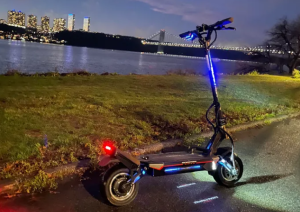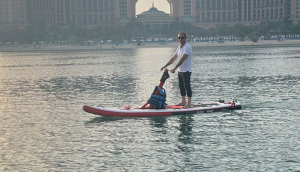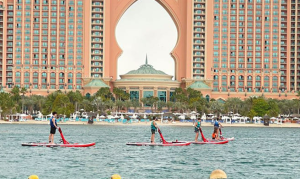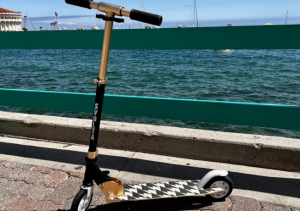Yes, water scooters, also known as personal watercraft, allow travel on water, offering speed and agility.
Introduction
Water scooters, often referred to as personal watercraft (PWC), represent a significant evolution in water transportation, offering an exhilarating blend of speed, agility, and freedom on the water. These vehicles have transformed aquatic leisure, enabling enthusiasts to explore water bodies in ways that were previously unimaginable.
Overview of Water Scooters
Water scooters are engineered marvels designed for aquatic environments, enabling individuals to glide across water surfaces at impressive speeds. Key models such as the Yamaha WaveRunner and the Sea-Doo line have dominated the market, offering advanced features that cater to both beginners and seasoned enthusiasts. These scooters are renowned for their high-performance engines, capable of reaching speeds up to 70 mph, and innovative design that ensures stability and agility in water.
The appeal of water scooters lies in their versatility and ease of use. Unlike traditional boats, they require minimal maintenance, making them a popular choice among water sports enthusiasts. The cost of entry-level models starts around $5,000, with high-end models reaching $15,000, offering a range of options for different budgets and preferences.
Evolution of Water Transportation
The evolution of water transportation has been marked by significant milestones, from the invention of the simple canoe to the development of modern water scooters. The transition from paddle-powered vessels to engine-driven machines marked a turning point in aquatic mobility, significantly reducing the effort required to traverse water and opening up new possibilities for exploration and recreation.
In the past decade, technological advancements have further enhanced the capabilities of water scooters. The introduction of electric models represents a leap forward in eco-friendly transportation, offering zero-emission alternatives to traditional gasoline-powered scooters. These electric variants not only contribute to environmental conservation but also provide a quieter, smoother ride, enhancing the user experience.
The shift towards more sustainable models highlights the industry’s commitment to innovation and environmental stewardship. Manufacturers are continually exploring new materials and technologies to improve the efficiency, durability, and performance of water scooters, ensuring they remain at the forefront of water transportation evolution.
Water scooters exemplify the remarkable progress in human ingenuity and the endless pursuit of enhancing our interaction with the world’s waterways. As technology advances, these vehicles will continue to offer unparalleled experiences on the water, pushing the boundaries of what is possible in aquatic recreation and transportation.
Types of Water Scooters
The realm of water scooters is broadly divided into two categories: stand-up and sit-down models. Each type offers a unique set of features tailored to different preferences and skill levels.
Stand-up Water Scooters
Stand-up water scooters are the epitome of agility and performance in the water. Designed for a single rider, these models demand a higher level of physical fitness and skill, as they require the rider to stand and balance while maneuvering. The Kawasaki Jet Ski is a notable example in this category, renowned for its powerful engine and sleek design.
Key Features:
- Engine Power: Ranges from 60 to 150 horsepower, enabling top speeds of up to 65 mph.
- Weight Capacity: Generally supports up to 250 pounds, making it suitable for individual use.
- Cost: Prices start at approximately $8,000, appealing to serious enthusiasts and competitive riders.
Advantages:
- Offers superior maneuverability and speed.
- Ideal for tricks, racing, and high-intensity water sports.
Disadvantages:
- Steeper learning curve compared to sit-down models.
- Limited to use by one rider at a time.
Sit-down Water Scooters
Sit-down water scooters are designed for comfort and stability, accommodating one to three passengers. These models are perfect for families and individuals seeking a more relaxed experience on the water. The Sea-Doo GTI series exemplifies the sit-down scooter, offering a comfortable ride with plenty of storage space and user-friendly controls.
Key Features:
- Engine Power: Ranges from 130 to 300 horsepower, with speeds up to 70 mph.
- Weight Capacity: Can accommodate up to 600 pounds, suitable for multiple riders.
- Cost: Entry-level models start around $10,000, with luxury models reaching $18,000.
Advantages:
- More stable and easier for beginners to operate.
- Suitable for longer rides and touring.
Disadvantages:
- Larger size makes storage and transport more challenging.
- Less agile than stand-up models.
Here’s a comparison of the two types based on the discussed parameters:
| Feature | Stand-up Water Scooters | Sit-down Water Scooters |
|---|---|---|
| Engine Power | 60-150 HP | 130-300 HP |
| Top Speed | Up to 65 mph | Up to 70 mph |
| Weight Capacity | Up to 250 lbs | Up to 600 lbs |
| Cost | Starts at ~$8,000 | Starts at ~$10,000 |
| Rider Capacity | 1 | 1-3 |
| User Level | Advanced/Sport | Beginner to Intermediate |
| Maneuverability | High | Moderate |
| Purpose | Racing, Tricks, Sport | Leisure, Family, Touring |
Each type of water scooter serves a distinct purpose and caters to different audiences. Stand-up models are geared towards those seeking thrill and sport, while sit-down scooters offer a more accessible and comfortable experience for leisure and family activities.
Design and Technology
The design and technology of water scooters are crucial elements that define their performance, durability, and overall user experience. Manufacturers invest heavily in research and development to ensure that these vehicles not only meet but exceed the expectations of end-users in various aspects such as speed, efficiency, and environmental impact.
Engineering Behind Water Scooters
The engineering of water scooters involves a sophisticated blend of hydrodynamics, mechanical engineering, and materials science. The core of a water scooter’s performance lies in its engine and propulsion system. Modern water scooters are equipped with two types of engines: two-stroke and four-stroke, with the latter becoming more prevalent due to its efficiency and lower emissions. Four-stroke engines typically offer 20% to 30% more fuel efficiency than their two-stroke counterparts and significantly reduce harmful emissions, aligning with global environmental standards.
Propulsion is another critical aspect, with most water scooters utilizing jet propulsion systems. This system works by drawing water into a pump jet inside the craft and then expelling it through a nozzle at the rear, propelling the scooter forward. This design eliminates the need for external propellers, enhancing safety for the riders and marine life.
Materials used in construction play a vital role in the durability and performance of water scooters. High-grade marine aluminum is often used for the engine components to resist corrosion, while reinforced fiberglass or carbon fiber composites make up the hull and body. These materials offer an optimal balance between strength and weight, ensuring longevity and efficiency.
Materials and Durability
Durability is a paramount consideration in the design of water scooters, dictating their lifespan and reliability. The choice of materials directly impacts a scooter’s resistance to environmental challenges such as saltwater corrosion, UV exposure, and physical impacts. Carbon fiber composites, while more expensive than fiberglass, provide a higher degree of strength and fatigue resistance, making them ideal for high-performance models. These materials can withstand the rigorous demands of high speeds and rough waters, ensuring that the scooter maintains its integrity over time.
Manufacturers also apply advanced coatings and treatments to protect against corrosion and UV damage. These treatments can significantly extend the life of a water scooter, reducing the need for frequent repairs and replacements. Innovations in polymer science have led to the development of UV-resistant coatings that protect the scooter’s surface from fading and degradation, preserving its aesthetic appeal and functionality.
The integration of advanced electronics and control systems has also enhanced the safety and usability of water scooters. Features electronic brake and reverse (iBR) systems, developed by companies like Sea-Doo, allow for greater control and maneuverability, particularly in tight spaces. These systems not only improve the riding experience but also contribute to the overall safety of the vehicle, a critical factor given the high speeds at which these scooters can operate.
Performance and Specifications
The allure of water scooters is not just in their ability to navigate water but also in their performance and specifications, which are pivotal in defining the user experience. Manufacturers continuously push the envelope in enhancing speed, maneuverability, battery life, and charging efficiency, ensuring that riders enjoy both thrill and convenience.
Speed and Maneurability
Speed is a key factor that attracts enthusiasts to water scooters. Modern models are capable of reaching speeds up to 70 mph (113 km/h), with high-performance variants pushing even beyond this limit. This speed is made possible by powerful engines that range from 130 to 300 horsepower, depending on the model and make. The Yamaha WaveRunner FX SVHO and Sea-Doo RXT-X are prime examples, showcasing not just raw speed but also exceptional handling and agility.
Maneuverability is equally important, especially when navigating through challenging water conditions or tight spaces. Advanced hull designs and responsive steering systems enable riders to make sharp turns, jump waves, and perform tricks with precision. Jet propulsion technology further enhances maneuverability by allowing for instantaneous direction changes and reverse motion without the need for moving external parts.
Battery Life and Charging
As the industry moves towards sustainability, electric water scooters are gaining prominence. Battery life in these models is a critical aspect that determines their usability and appeal. Current electric water scooters offer battery life that can last up to 2 hours on a single charge, with variations based on usage patterns and conditions. Riding at full throttle will consume battery life faster than cruising at moderate speeds.
Charging is another vital consideration for electric water scooter users. Advances in battery technology and charging infrastructure have significantly reduced charging times. Modern electric water scooters can be recharged from 0 to 80% in as little as 2 hours with high-capacity chargers. This improvement not only enhances convenience but also ensures that riders can spend more time enjoying the water rather than waiting for their scooters to recharge.
The development of fast-charging stations and portable chargers has further eased the concerns regarding range and charging availability. Riders can now plan longer journeys with confidence, knowing that recharging their scooters will not be a major impediment.
The performance and specifications of water scooters are central to their appeal and functionality. With manufacturers focusing on enhancing speed, maneuverability, battery life, and charging efficiency, riders can look forward to even more advanced and enjoyable models in the future. The blend of technology, design, and innovation continues to push the boundaries of what water scooters can achieve, offering unprecedented experiences on the water.
Use Cases
Water scooters, with their versatile designs and capabilities, cater to a wide range of activities beyond just personal enjoyment. From recreational use to professional and rescue operations, these vehicles have become indispensable in various scenarios, each demanding specific features and functionalities.
Recreational Use
Recreational use is the most common scenario for water scooters, encompassing activities such as touring, racing, and performing tricks. Families and individuals alike treasure the freedom and excitement that water scooters provide, allowing them to explore lakes, rivers, and coastal areas with ease. Models like the Sea-Doo Spark have become popular for their affordability, offering an entry-level price point of around $5,500, making water scooting accessible to a broader audience.
For enthusiasts seeking adrenaline, high-speed models capable of reaching up to 70 mph offer the thrill of racing against the wind and waves. The agility of these scooters also enables riders to perform impressive maneuvers, from sharp turns to freestyle jumps. The Yamaha WaveRunner EXR, stands out for its performance-oriented design, providing an optimal blend of speed and maneuverability for advanced riders.
Professional and Rescue Operations
Beyond leisure, water scooters play a crucial role in professional and rescue operations, where speed, reliability, and durability are paramount. Rescue agencies and lifeguards rely on specially equipped water scooters for rapid response to emergencies on the water. These models are outfitted with additional features rescue boards, sirens, and GPS navigation to assist in search and rescue missions.
The Kawasaki Jet Ski Ultra LX is an example of a model that has been adapted for such operations, offering a balance of high performance and stability, with the capacity to carry rescue equipment and a passenger safely. Its fuel efficiency and extended range ensure that rescue teams can operate for longer periods without the need for frequent refueling.
In professional settings, such as water sports instruction and aquatic patrols, water scooters facilitate efficient oversight and management of water-based activities. Their maneuverability allows for close monitoring of areas where boats might not be able to reach, ensuring safety and compliance with regulations.
Water scooters serve a wide array of use cases, from providing entertainment and recreation to fulfilling critical roles in professional and rescue operations. Their design and technology continue to evolve, meeting the diverse needs of users across the spectrum. With advancements in efficiency, safety, and performance, water scooters will undoubtedly remain a fixture in aquatic activities for years to come.





